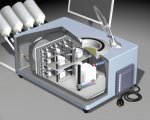Home > Nanotechnology Press Kit > Molecular Manufacturing Myths
Nanotechnology Press Kit - Molecular Manufacturing Myths
Last Updated: Monday, 20-Apr-2015 19:51:34 PDT
Molecular Manufacturing Myths
Perhaps the biggest myth is that molecular manufacturing is impossible. Before we get into the alleged reasons, it helps to remember how mundane it is: it's just very small machines, making chemistry happen according to plan.
The explanations given here are accurate, but simplified. If you want more detail, please contact the author at cphoenix [at] CRNano.org. He will be happy to defend and explain these statements in as much detail as necessary.
Go directly to:
Part 1: "The chemistry won't work."
Part 2: "The machines won't work."
Part 3: "There's no point."
Part 4: "It's all just science fiction."
Part 5: "It's all about dangerous self-replicating nanobots."
Back to top
Part 1: "The chemistry won't work."
Myth: You can't build machines with chemistry because you can't pick up individual atoms.
Fact: This is a straw man. No one has proposed picking up individual atoms. What can be done-it happens all the time in nature-is to transfer groups of atoms from one molecule to another.
Myth: Atoms won't stay where they're put, because of quantum uncertainty, Heisenberg uncertainty, thermal noise, etc.
Fact: That depends on how the atoms are connected to other atoms. For example, diamonds don't evaporate. Not at all-not even one atom per year. This objection is like arguing that airplanes are impossible because they can't be built out of mud.
Myth: You can't make chemical reactions happen where you want them because it's too hard to control the surrounding atoms. (Sometimes stated as: It would take too many "fingers.")
Fact: Again, this depends on how the atoms are connected. Underwater chemistry is complex, but biology manages to do it. Chemistry in other environments may be a lot simpler. There's quite a bit of evidence that points to several different ways to build programmable shapes. If someone says it's impossible, ask for their evidence, and ask them about DNA folding, organic synthesis of graphite and fullerenes, and removal and replacement of single silicon atoms. (See Technical Bibliography for Research on Positional Mechanosynthesis or contact the author for more information [rfreitas at rfreitas dot com])
Myth: Chemistry is too complex, and it'll be difficult or impossible to build machines with it.
Fact: The point of molecular manufacturing is to use just a few reactions over and over again to build aggregated molecules. Building a brick wall is easy because you only need one kind of brick. Similarly, building a shape out of diamond is expected to be easy if you can add the atoms a few at a time, using the same reaction in multiple programmed locations. This plan shifts the complexity from chemistry to positional control-which can be controlled by software, and software is easy to write.
Back to top
Part 2: "The machines won't work."
Myth: There's no way to control such small machines.
Fact: There are lots of ways, including simply running wires to them. Whoever says this is obviously unfamiliar with the scientific literature.
Related Myth: There's no way to power such small machines.
Fact: Again, there are lots of ways, with chemicals, electricity, light, and even sound pressure. If someone says this, ask them about the "nano-elevator" which might be controlled by chemicals, electricity, or light, and which may allow "tight control over the timing of a reaction." (See Tiny 'elevator' most complex nanomachine yet)
Myth: Brownian motion (or thermal noise) will prevent the machines from working.
Fact: Thermal noise will make things wiggle a bit. But this has been taken into account in detailed engineering calculations. Large machines also have to deal with vibration. And cellular machinery, which is built a lot more loosely, manages to work just fine.
Related Myth: Nanomachines can't work because they don't use Brownian motion like biology does.
Fact: Several nanomachine designs do use Brownian motion. Others simply work around it. Biology doesn't always use it either. There's nothing magical about Brownian motion, and no rule that it has to be used, any more than larger machines must all use electricity.
Myth: Friction will prevent the machines from working.
Fact: With precise molecular construction techniques, surfaces can be made hard and smooth enough and positioned so that the friction drops to near-zero. This is called "superlubricity" and has recently been demonstrated. (See Superlubricity: a state of vanishing friction)
Myth: Things are weird ("quantum") at that small scale, and familiar engineering just won't work.
Fact: Cells are chock-full of molecular machines like turbines, trusses, ratchets, and so on. It's possible to build things that depend on quantum effects, but we already know of lots of molecular machines that don't.
Myth: Entropy will keep molecular machines from working.
Fact: Entropy can be held at bay by putting energy into a system. Your computer does trillions of calculations without a single error. Your body is constantly rebuilding itself. Entropy doesn't magically get worse at the nanoscale-in fact, the more precisely a machine is built, the more efficiently it can run. Entropy has been accounted for in molecular machine designs, and it turns out not to be a big deal. (On average, entropy would require less than one error per billion tons of diamond - one defect per 1.6x10^25 tons.)
Unraveling the Big Debate over Small Machines:Nanobot naysayers argue that molecular manufacturing is impossible, but the evidence goes against them
In the spirit of "myth busting," and presented in an article for BetterHumans, writer Patrick Bailey sets forth on a journey of explanation, into the nanorealm. In Unraveling the Big Debate over Small Machines, Bailey carefully lays out the history of several complex and key issues; issues that have been used to slow the pace of our understanding of molecular manufacturing.
|
Back to top
Part 3: "There's no point."
Myth: Mechanical chemistry will be far too slow to build anything useful.
Fact: A mechanical chemistry machine won't be too slow to build additional tiny machines. In fact, a nanoscale robot arm doing chemistry should be able to build its own mass in a few hours-maybe even minutes. Detailed plans exist for combining lots of these tiny machines into an integrated factory that could make large products. So there's no problem with productivity. (See Design of a Primitive Nanofactory)
Myth: Biology is better than anything we can build.
Fact: Biology never invented the digital computer, internal combustion, or even the wheel. Try putting three hundred actual horses under the hood of your sports car! Biology is very good at surviving on its own in ecosystems. But engineering, whether large-scale or nanoscale, is better at simple powerful things that modern humans tend to want-like compact motors and fast computers.
Related Myth: Nanomachine designs are unnatural and therefore inefficient. (Sometimes stated as: nanomachines are too rigid and have to spend lots of energy to do anything.)
Fact: Biology includes some great tricks-and nanomachines can use them too. But sometimes, rigid is better (see the "friction" myth). And by the way, if someone gives diffusion as an example of biology being better, they're wrong: making something diffuse takes just as much energy as dragging it (the Einstein, Stokes, and Shannon equations cancel out).
Related Myth: Other technologies will do just as well.
Fact: Precise nanoscale machines have several special advantages. Being small, they can operate more quickly-and thus more efficiently. Being precise, they can have very low friction. And being built with atoms, which are discrete, pliant, and identical, each copy of a machine can be very predictable and reliable. All of this is basic physical law, not speculation.
Myth: It's too hard to do-it'll take many decades if it can be done at all.
Fact: We won't know for sure until it's done. But it doesn't look that hard to design a few chemical reactions, and a few molecular machines, and some larger systems, and some software to pull it together, and a nano-manipulation or enzymatic system to build the first one. Each step requires only engineering, not complex system design. The military payoff alone will probably tempt nations to spend billions on developing it. A lot of people are now saying it could take ten to fifteen years; I think it could be as little as five, especially if one or more nations are already working on it.
Myth: It'll be nearly impossible to design products for a molecular manufacturing system, so it won't have much impact.
Fact: Once a few basic molecular machines have been designed, they can be recombined in many ways to make almost any product you can think of. Software engineers do this kind of thing all the time, compiling a few instructions into large programs-and never having to think about the physical chips. And most of today's products are a lot less complex than today's software programs.
|
From Leading nanotech experts puts 'grey goo' in perspective.
"An obsession with obsolete science-fiction images of swarms of replicating nanobugs has diverted attention from the real issues raised by the coming revolution in molecular nanotechnologies," said Drexler. "We need to focus on the issues that matter - how to deal with these powerful new capabilities in a competitive world."

(*) Artist's concept of a desk top factory. See All About Bootstrapping for more.
Image courtesy of and © John Burch, Lizard Fire Studios, http://www.lizardfire.com Click here for expanded view of core mechanism. (1551 x 1380 - 851K) |
Back to top
Part 4: "It's all just science fiction."
Myth: Molecular manufacturing hasn't appeared in peer-reviewed scientific literature.
Fact: This is incorrect. For example, there's Eric Drexler's 1981 PNAS paper, Ralph Merkle's publications in Nanotechnology in the mid-1990's, and a wide range of theory and experiment papers on mechanosynthesis (See Technical Bibliography for Research on Positional Mechanosynthesis)
Myth: Nanobots just aren't well thought out: no power, control, heat dissipation, etc.
Fact: There's a lot of fiction and "artist's conception" floating around. But anyone who tars all nanomachine work with that brush is seriously ignorant. There's a lot of serious engineering work, with nanomachines, robots, and even desktop integrated manufacturing systems worked out in detail. (See Nanosystems by Eric Drexler, Nanomedicine Vol. I by Robert Freitas, and Design of a Primitive Nanofactory by Chris Phoenix)
Back to top
Part 5: "It's all about dangerous self-replicating nanobots."
Myth: Products of molecular manufacturing must be small.
Fact: It won't be hard to integrate many nanoscale production systems into a factory that joins their output to make large products. This will be a lot more convenient and efficient than trying to keep track of zillions of tiny assemblers and nanobots. (See Design of a Primitive Nanofactory)
Myth: Every product of molecular manufacturing will self-replicate.
Fact: This would be as inefficient as building an oil refinery and a machine shop into every car. In fact, even the manufacturing systems won't self-replicate, since they'll require preprocessed chemicals.
Myth: A laboratory accident could unleash a "gray goo" of nanobots on the world.
Fact: During the development as well as the use of mechanical molecular manufacturing systems, there will be no reason to build anything even close to a self-replicator. Gray goo would take a lot of hard, pointless design work. Even for military purposes, it would be quite inefficient (think of the car with the built-in oil refinery). A bigger concern appears to be deliberate production of non-replicating weapons. (See Safe Exponential Manufacturing)
We encourage debate. Please use this form to tell us what you think.
|
|
|
|
||
|
|
||
| The latest news from around the world, FREE | ||
|
|
||
|
|
||
| Premium Products | ||
|
|
||
|
Only the news you want to read!
Learn More |
||
|
|
||
|
Full-service, expert consulting
Learn More |
||
|
|
||
